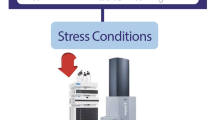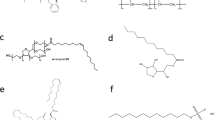Abstract
Purpose
In vitro lipolysis is widely utilized for predicting in vivo performance of oral lipid-based formulations (LBFs). However, evaluation of LBFs in the absence of an absorption sink may have limited in vivo relevance. This study aimed at employing biopharmaceutical modeling to simulate LBF digestion and drug supersaturation in a continuous absorptive environment.
Methods
Three fenofibrate-loaded LBFs were characterized in vitro (dispersion and lipolysis) and drug precipitation was monitored using in-line Raman spectroscopy. In vitro data were combined with pharmacokinetic data derived from an in vivo study in pigs to simulate intestinal LBF transit. This biopharmaceutical model allowed calculation of lipolysis-triggered drug supersaturation while drug and lipolysis products are absorbed from the intestine.
Results
The biopharmaceutical model predicted that, in a continuous absorption environment, fenofibrate supersaturation was considerably lower compared to in vitro lipolysis (non-sink). Hence, the extensive drug precipitation observed in vitro was predicted to be unlikely in vivo. The absorption of lipolysis products increased drug supersaturation, but drug precipitation was unlikely for highly permeable drugs.
Conclusions
Biopharmaceutical modeling is a valuable approach for predicting LBFs performance in vivo. In the absence of in vitro tools simulating absorptive conditions, modeling strategies should be further considered.












Similar content being viewed by others
References
Porter CJH, Trevaskis NL, Charman WN. Lipids and lipid-based formulations: optimizing the oral delivery of lipophilic drugs. Nat Rev Drug Discov. 2007;6:231–48.
Shah NH, Carvajal MT, Patel CI, Infeld MH, Malick AW. Self-emulsifying drug-delivery systems (SEDDS) with polyglycolyzed glycerides for improving in-vitro dissolution and oral absorption of lipophilic drugs. Int J Pharm. 1994;106:15–23.
Devraj R, Williams HD, Warren DB, Mullertz A, Porter CJH, Pouton CW. In vitro digestion testing of lipid-based delivery systems: Calcium ions combine with fatty acids liberated from triglyceride rich lipid solutions to form soaps and reduce the solubilization capacity of colloidal digestion products. Int J Pharm. 2013;441:323–33.
Sassene PJ, Knopp MM, Hesselkilde JZ, Koradia V, Larsen A, Rades T, et al. Precipitation of a poorly soluble model drug during in vitro lipolysis: characterization and dissolution of the precipitate. J Pharm Sci. 2010;99:4982–91.
Thomas N, Holm R, Mullertz A, Rades T. In vitro and in vivo performance of novel supersaturated self-nanoemulsifying drug delivery systems (super-SNEDDS). J Control Release. 2012;160:25–32.
Brouwers J, Brewster ME, Augustijns P. Supersaturating drug delivery systems: the answer to solubility-limited oral bioavailability? J Pharm Sci. 2009;98:2549–72.
Yeap YY, Trevaskis NL, Porter CJH. The potential for drug supersaturation during intestinal processing of lipid-based formulations may be enhanced for basic drugs. Mol Pharmaceutics. 2013;10:2601–15.
Sek L, Porter CJH, Charman WN. Characterisation and quantification of medium chain and long chain triglycerides and their in vitro digestion products, by HPTLC coupled with in situ densitometric analysis. J Pharmaceut Biomed. 2001;25:651–61.
Zangenberg NH, Mullertz A, Kristensen HG, Hovgaard L. A dynamic in vitro lipolysis model I. Controlling the rate of lipolysis by continuous addition of calcium. Eur J Pharm Sci. 2001;14:115–22.
Fatouros DG, Mullertz A. In vitro lipid digestion models in design of drug delivery systems for enhancing oral bioavailability. Expert Opin Drug Metab Toxicol. 2008;4:65–76.
Shi Y, Gao P, Gong YC, Ping HL. Application of a biphasic test for characterization of in vitro drug release of immediate release formulations of celecoxib and its relevance to in vivo absorption. Mol Pharmaceutics. 2010;7:1458–65.
Kataoka M, Sugano K, Mathews CD, Wong JW, Jones KL, Masaoka Y, et al. Application of dissolution/permeation system for evaluation of formulation effect on oral absorption of poorly water-soluble drugs in drug development. Pharm Res. 2012;29:1485–94.
Fei Y, Kostewicz ES, Sheu MT, Dressman JB. Analysis of the enhanced oral bioavailability of fenofibrate lipid formulations in fasted humans using an in vitro–in silico–in vivo approach. Eur J Pharm Biopharm. 2013;85:1274–84.
Stillhart C, Imanidis G, Kuentz M. Insights into drug precipitation kinetics during in vitro digestion of a lipid-based drug delivery system using in-line Raman spectroscopy and mathematical modeling. Pharm Res. 2013;30:3114–30.
Griffin BT, Kuentz M, Vertzoni M, Kostewicz ES, Fei Y, Faisal W, Stillhart C, O'Driscoll C, Reppas C, Dressman JB. Comparison of in vitro tests at various levels of complexity for the prediction of in vivo performance of lipid-based formulations. Eur J Pharm Biopharm. 2014;86(3):427–37.
Geladi P, Kowalski BR. Partial least-squares regression - A tutorial. Anal Chim Acta. 1086;185:1-17
Anby MU, Williams HD, McIntosh M, Benameur H, Edwards GA, Pouton CW, et al. Lipid digestion as a trigger for supersaturation: evaluation of the impact of supersaturation stabilization on the in vitro and in vivo performance of self-emulsifying drug delivery systems. Mol Pharmaceutics. 2012;9:2063–79.
Najib J. Fenofibrate in the treatment of dyslipidemia: A review of the data as they relate to the new suprabioavailable tablet formulation. Clin Ther. 2002;24:2022–50.
Kararli TT. Comparison of the gastrointestinal anatomy, physiology, and biochemistry of humans and commonly used laboratory animals. Biopharm Drug Dispos. 1995;16:351–80.
Avdeef A, Tam KY. How well can the Caco-2/Madin-Darby canine kidney models predict effective human jejunal permeability? J Med Chem. 2010;53:3566–84.
Jantratid E, Janssen N, Reppas C, Dressman JB. Dissolution media simulating conditions in the proximal human gastrointestinal tract: An update. Pharm Res. 2008;25:1663–76.
Shah VP, Tsong Y, Sathe P, Liu JP. In vitro dissolution profile comparison - Statistics and analysis of the similarity factor, f2. Pharm Res. 1998;15:889–96.
Yalkowsky SH. Solubility and solubilization in aqueous media. Washington NY: Oxford University Press; 1999. pp. 236-320.
Grove M, Pedersen GP, Nielsen JL, Mullertz A. Bioavailability of seocalcitol I: Relating solubility in biorelevant media with oral bioavailability in rats - Effect of medium and long chain triglycerides. J Pharm Sci. 2005;94:1830–8.
Fernandez S, Jannin V, Rodier JD, Ritter N, Mahler B, Carrière F. Comparative study on digestive lipase activities on the self emulsifying excipient Labrasol®, medium chain glycerides and PEG esters. Biochim Biophys Acta Mol Cell Biol Lipids. 2007;1771:633–40.
Fernandez S, Rodier JD, Ritter N, Mahler B, Demarne F, Carrière F, et al. Lipolysis of the semi-solid self-emulsifying excipient Gelucire® 44/14 by digestive lipases. Biochim Biophys Acta Mol Cell Biol Lipids. 2008;1781:367–75.
Williams H, Sassene P, Kleberg K, Calderone M, Igonin A, Jule E, et al. Toward the establishment of standardized in vitro tests for lipid-based formulations, Part 3: Understanding supersaturation versus precipitation potential during the in vitro digestion of type I, II, IIIA, IIIB and IV lipid-based formulations. Pharm Res. 2013;30:3059–76.
Williams HD, Sassene P, Kleberg K, Bakala-N'Goma JC, Calderone M, Jannin V, et al. Toward the establishment of standardized in vitro tests for lipid-based formulations, part 1: Method parameterization and comparison of in vitro digestion profiles across a range of representative formulations. J Pharm Sci. 2012;101:3360–80.
Sugano K. Biopharmaceutics modeling and simulations. Hoboken NJ: Wiley; 2012.
Mullin JW. Crystallization. Oxford: Butterworth-Heinemann; 2001.
Vertzoni M, Markopoulos C, Symillides M, Goumas C, Imanidis G, Reppas C. Luminal lipid phases after administration of a triglyceride solution of danazol in the fed state and their contribution to the flux of danazol across Caco-2 cell monolayers. Mol Pharmaceutics. 2012;9:1189–98.
Miller JM, Beig A, Krieg BJ, Carr RA, Borchardt TB, Amidon GE, et al. The solubility-permeability interplay: mechanistic modeling and predictive application of the impact of micellar solubilization on intestinal permeation. Mol Pharmaceutics. 2011;8:1848–56.
Mohsin K, Long MA, Pouton CW. Design of lipid-based formulations for oral administration of poorly water-soluble drugs: precipitation of drug after dispersion of formulations in aqueous solution. J Pharm Sci. 2009;98:3582–95.
Author information
Authors and Affiliations
Corresponding author
Rights and permissions
About this article
Cite this article
Stillhart, C., Imanidis, G., Griffin, B.T. et al. Biopharmaceutical Modeling of Drug Supersaturation During Lipid-Based Formulation Digestion Considering an Absorption Sink. Pharm Res 31, 3426–3444 (2014). https://doi.org/10.1007/s11095-014-1432-1
Received:
Accepted:
Published:
Issue Date:
DOI: https://doi.org/10.1007/s11095-014-1432-1




